The Road to Goka in the Manga Hyougemono and Revenge of the Sith 漫画へうげものとスターウォーズ:シスの復讐で描かれる業火への道
日本在住この二十年 (2022年6月現在)のあまり、日本語だけではなく、日本の文化と宗教観に対する理解をさらに深まるように尽力してきた(いや、今もそれが進行中)。そして、その「日本フィルタ」を通してスターウォーズ(以降SW)を改めてみると、新たな視点からその物語を垣間見えるようになった。
I have spent nearly two decades of my life in Japan (as of June 2022), and during that time I have worked hard (or rather still working) to deepen my knowledge of not only the Japanese language, but also the culture and religious perspective of the country. This "Japan filter" has provided me with new insight and perspective into repeat viewings of the Star Wars (SW) saga.


Source: Lucasfilm
SWの第一話~6話までの主人公であるアナキンスカイウォーカーがダースベイダーに生まれ変わるシーンに対して新たな解釈のヒントを与えた日本語の単語がある:「業火」。この単語は元々仏教の用語であり、辞書で載っている意味はこうである:「悪業(あくごう)が身を滅ぼすのを火にたとえていう語。また、罪人を焼き苦しめる地獄の火。」この言葉を成り立つ漢字を分解しますと「業」と「火」となり、その二つの字が描くイメージからその意味を何とか察することもできる。
There is one Japanese word that has added a new layer of interpretation to the scene in which Anakin Skywalker, the protagonist of the SW saga, becomes Darth Vader: 業火 (goka). The word "goka" comes from Buddhism, and the meaning listed in the dictionary goes something like this: "Analogy that likens the evil deeds one commits to a fire that envelopes them. Also the fires of hell that inflict suffering upon the wicked." The two characters that make up this word, 業 and 火, convey the ideas of "deeds" and "fire", making it easy to surmise what the meaning of the word is.

辞書に載っている意味は確かに分かりやすくて、その言葉が表す苦しみを簡単に想像できる一方、本来は仏教においてより深淵な意味合いが織り込まれている。 まず、仏教の教えでは、すべての生き物は煩悩(ぼんのう)に満ちている限り、悪業を重ねざるを得ない。自分が悪業の結果すごく苦しむことを、火に焼かれ苦しむことがまさに「業火」ということなのだ。煩悩といえば、その一つは力に対する欲望であるともいえよう。
The dictionary definition is pretty straight forward, making it easy to conjure up the images of suffering it conveys. However, the original meaning in its Buddhist context is actually deeper. Buddhism states that people are doomed to pile up iniquities so long as they remain consumed by worldly passions and carnal desires. In this sense, we can classify a lust for power as one of these so-called passions and desires.
 Source: Anime Hyougemono
Source: Anime Hyougemono
「業火」という単語を始めて出逢ったのは「へうげもの」という漫画の中であった。漫画の主人公である古田織部の茶の湯の師匠であった千利休が、昔の親友であったヘチカンを訪れたシーンの中で「業火」の単語が出てくる。そのシーンで描かれる会話は下記の通り:。
The first time I came across the word "goka" was in the manga Hyougemono. The scene in which it is used depicts Sen no Rikyuu, the tea master of the story's protagonist Furuta Oribe, paying a visit to an old friend Hechikan. Here is the conversation exchanged between the two.
千利休:「何をなさっておるのです?」
Sen no Rikyu: What have you been doing as of late?
ヘチカン:「ワシももう永くない。書物やら道具やら、少しづつ処分しておるのよ。どうだい?おまえさんも身の回りを片づけたら。風雅は身と共に終わるべしってな」
Hechikan: I don't have much longer. Little by little, I've been getting rid of my writings and tea vessels. You should do the same. The fate of these refined trappings will be the same as mine.
千利休:「・・・あまり、感心しませんな」
Sen no Rikyu: I pictured you doing something much grander.
ヘチカン:「業が深いの。関白(豊臣秀吉)さんよりよっぽど」
Hechikan: You've seen to have accomplished quite a lot. Even more than the Kanpaku (Toyotomi Hideyoshi) himself.
千利休:「左様にございます。さりとて、私の業の働きゆえ、世が侘び色に染まるなら、今生きている者たちが誠の美を見出すなら、争いなど消え失せ、心静かに暮らしを営めましょう」
Sen no Rikyu: Indeed I have. I've been working to spread the philosophy of wabi (sober refinement, beauty in simplicity). In doing that, I hope to help people living now discover true beauty. That discovery will purge this land of conflict, enabling all to live in peace."
ヘチカン:「はあ、二十年の歳月は人を変えるものよのお。おまえさんは天下国家にまで口を出す仁じゃなかった。過ぎたるはなお及ばざるが如し。それはおまえさんにも言えるのと違うのかえ? 己のことは見えがたいものよ」
Hechikan: Humph, 20 years can really change a man. I never thought of you as one to espouse such an ambitious vision for unifying the country under a singular mandate. Too much of a good thing can be bad, you know. But do you really see that? You've lost sight of yourself.
千利休:「・・・・」
Sen no Rikyuu: (Silence)
ヘチカン:「もう生きて会うこともないから言っておくぞ。人の欲の達成には限りがあるのじゃ」
Hechikan: I say this to you because this is probably the last time we'll meet in this life. There is a limit to what a man's ambition can achieve.
千利休:「私では、皆に侘びを伝えられぬと申されますか?」
Sen no Rikyu: Are you saying that it's impossible for me to spread the wabi philosophy?
ヘチカン:「・・・限りを知らねば禍を招きかねん。今の利休居士は、業火にもまれとるよ」
Hechikan: The inability to recognize your limits ultimately courts disaster. Rikyu, there's a goka all around you. I see it.

漫画で初めてこのシーンを読んだとき「業火」に織り込められている意味合いを完全に理解していなかったものの、上記で記述した通りその漢字からなんとかその意味を察することが出来た。そしてこのシーンを読み終えた瞬間に「利休の身は恐ろしい炎に包まれている」という絵が思い浮かんだ。その後に手元の国語辞書でこの単語の意味を調べて、それを確認することによってこのシーンが与える衝撃が一層に大きくなった。
The first time I read this scene I did not fully understand the meaning of the word goka. However, just as I wrote above, I was able to partially infer what it meant from the two kanji that make up the word. At that instant, an image of Rikyu enveloped in flames flashed through my mind. The impact of this scene grew even larger when I later looked up and checked the meaning of this word in the Japanese/Japanese dictionary I had.

さて、このシーンでヘチカンが言う利休の「業」は一体どういう業なのだろうか?へうげものの概要をまとめるウィキペディアの記事は利休についてこう書かれている:「日本を己の数奇に基づく「わび」の理想国家へと作り変えたいという「業」から秀吉を見込み、信長殺しを持ちかけ暗躍、実行する。豊臣政権の樹立後は筆頭茶頭となり、その天才的な創意を振るうも秀吉との摩擦が多くなる。世に二つの花があっては煩雑であるという信念から帝を毒殺することを秀吉にそそのかすなど、美の理想の追求のためにはどのような行動も厭わない。
一時は己の中で温故知新を果たし穏やかな心を得るが、宗二(利休の弟子)の斬首への憎悪と絶望をきっかけに更なる業に己を染めていく。織部を巻き込まぬため絶縁を申し渡し、自らが作った豊臣政権を滅ぼすため再び暗躍するが、家康に光秀の最期を教えられ、自らの過ちを知って死に臨む。介錯を務めた織部に志を託し切腹した。」
So what exactly are the deeds of Rikyu that Hechikan is referring to in this particular scene? The Wikipedia overview (in Japanese) of the Hyougemono series contains this passage within its description of Rikyu:
"Rikyu believes that Hideyoshi (Toyotomi) is the man through which he can achieve his vision of transforming Japan into the ideal nation-state he seeks to create; one founded upon his very own wabi-infused vision of refined taste. To achieve this end, he works behind the scenes to set in motion a plot to assasinate Oda Nobunaga (at the hand of Akechi Mitsuhide). Rikyu is named the head tea master after Hideyoshi Toyotomi assumes power, but his creative genius proves to be a regular source of friction between himself and Hideyoshi. Believing that the world is not large enough for 'two flowers (two objects of beauty)', he tries to convince Hideyoshi to covertly poison and eliminate the Emperor. In short, he is willing to use any means necessary in pursuit of what he believes to be the ideal form of beauty.
Rikyu finds solace for a short time, drawing upon the lessons of the past as he works to break new ground in his pursuit of tea. However, the execution of his student Soji unleashes a well of hate and despair, leading him to further tarnish his soul with evil deeds. He severs his ties with Furuta Oribe, who refuses Rikyu's entreaties to join forces with him, and then works to plot the destruction of the Toyotomi government he created. It is only when Tokugawa Ieyasu tells him the final words of Akechi Mitsuhide that Rikyu realizes the error of his ways as he faces his own execution. He leaves Oribe with his vision for a country rooted in beauty, and accepts decapitation at his hand after committing seppuku."

フォースの暗黒面に潜む危険性についてルークを諭したときヨーダはこう伝えた:「一度闇の道を進み始めたら、闇が一生お前の運命を征服し食い尽くすじゃろう。」漫画へうげもので描かれる利休はヨーダが諭したの如く、一度悪業に手を染めたらその軌道からなかなか脱することができなかった。自分から見て地上の地獄である日本の乱世を終わらせるために自分が美の理想と見る侘びを礎に新な国の体制を築くために茶の湯を広めようとした。善意に基づいた志でもあったが、「地獄への道は善意で敷かれている」という諺の如く、その善意を果たすためにどのような行動も厭わず、そのあげく自分のことを見失ってしまい、成し遂げた「業」が生み出した「火」に滅ぼされた。
When Yoda admonishes Luke about the inherent dangers of the Dark Side of the Force, he says "Once you start down the dark path, forever will it dominate your destiny, consume you it will." This is exactly what we see happen with Rikyu in the manga Hyougemono. Once he taints himself with the stain of evil, he becomes unable to break away from the dark path it sends him down. He viewed the incessant conflict among warlords in Japan as a form of hell on earth, and sought to end it through tea ceremony evangelism in an effort to create a new national order rooted in the wabi he viewed as the ideal form of beauty. Yet, just as the saying "the road to hell is paved with good intentions" goes, his desire to achieve a benevolent end led him to use whatever means necessary to achieve it. In the end, he lost all sight of himself, and became consumed by the fire (火) sparked by his own evil deeds (業).

この経由で「業火」という単語を知るようになった以降、毎回この単語を見るとまず思い浮かぶのは漫画へうげもので描かれる欲望に支配される利休とその欲望が招いた「滅び」の展開だ。そして、この連想は「シスの復讐」でアナキンとオビワンの対決の末に溶岩の川の岸で炎に包まれるアナキンのシーンに新な解釈を与えられた。炎に包まれて焼き苦しめていくアナキンの姿を見た瞬間に、頭に浮かんだのはこの「業火」という言葉でした。そのシーンはまさにこの言葉の意味合いを見事に表現している。しかも、「シースの復讐」ではそのシーンで流れる曲のタイトルは英語で「Immolation」となっているけど、その邦訳のタイトルは「業火」である。おそらく、翻訳の段階でその仏教的な意味合いを意識したであろう。お見事な邦訳である。「業火」でアナキンがジェダイ撲滅に加担したことの罪を始め、そして自分の息子であるルークの慈悲と愛に救われて光に戻るときまでダースベイダーとして積み重ねていく罪をその溶岩の川の岸で焼き苦しい報いとして受けました。では、その悲惨な運命に駆り立てたのは一体何であったでしょう?ただ自分が愛するものを死から救いたかった善意でした。しかし、ヘチカンが利休に言ったように、アナキンの場合は愛が「過ぎたるはなお及ばざるが如し」ものとなり、そして自分を突き動かす愛は力への渇望に生まれ変わって、その結果自分の善意がダースベイダーという地獄への道を敷いてしまいました。
As a result of learning the word goka in this fashion, every time I see this word my mind races to the image of Rikyu driven by ambition, and the ultimate demise to which it led him in the manga Hyougemono. This line of thought added a new interpretation to the final battle between Obi Wan and Anakin in Revenge of Sith, in which Anakin is left consumed by flames on the banks of a lava river. Upon watching the film again and seeing Anakin writhing in pain, enveloped by flames, the word goka flashed through my mind. This scene truly and perfectly conveys the inherent meaning of the word. The title of the piece playing at this scene in Revenge of the Sith is "Immolation" in English, but the Japanese title is Goka (業火). I can't help but think the translator had the Buddhist connotations of this word in mind when the made the translation. It's perfect. Surrounded by his own goka on the banks of that lava river, Anakin suffers the pain of all the transgressions he commits as Darth Vader, from his part in the destruction of the Jedi Order until he is finally redeemed by the compassion and love of his son Luke. But what was it that compelled him onward to this tragic fate? His own good intentions, in short the desire to save the ones he loved. Yet, just as Hechikan said to Rikyu, "too much of a good thing can be bad." In Anakin's case, the love that drove him gave way to a lust for power. In the end, his own original good intentions proved to be the cobblestones that paved the way to the hell he came to know as Darth Vader.

斎藤隆夫粛軍演説 Takao Saitou’s Anti-Militarism Speech

この演説の存在を知ったのは、ちょうど2年前のことです。
さて、現在の日本に於いて、このような演説を能える政治家がいるのでしょうか?拙僧はそれを訝しむばかりです。
It was two years ago that I first learned of the existence of this speech.
Reading over it, I began thinking as to whether any of the politicians in Japan today would be capable of making such a speech. Needless to say I have my doubts.
日中戦争の勃発以降、日本政府は軍事主義一辺倒で疾走したと考えることが多いですが、その流に抗うものもいました。斎藤隆夫はその一人で、政府が売り込むような国策は本当に国民の権益のためになるかという強い疑問を抱えて、1940年(昭和15年)2月2日に帝国議会でその疑問を内閣始め政府にぶつかりました。その演説はいわる「斎藤隆夫粛軍演説」でした。
It is often thought that the Japanese government ran full speed, completely devoted to the precepts of militarism following the outbreak of the Sino-Japanese War. However, there were people who stood up and sought to stem the tide. Takao Saitou was one of these individuals. He was gravely concerned about whether the national policy pursued by the government was really in the best interests of the people, and decided to literally confront the Cabinet and the rest of the government with these doubts at a session of the Imperial Diet held on February 2, 1940. The speech he gave came to be known as Takao Saitou’s Anti-Militarism Speech.

斎藤隆夫粛軍演説(最後の一部を抜粋)
Takao Saitou’s Anti-Militarism Speech (Excerpt from the end of the speech)
(この国の為政者は)この現実を無視して、ただいたずらに聖戦の美名に隠れて、
They (the leaders of this country) turn a blind eye to reality, merely hiding vainly behind the façade of what they dress up as a holy war.
国民的犠牲を閑却し、
They ignore the sacrifices made by the people of this country,
曰く国際正義、曰く道義外交、
曰く共有共栄、曰く世界の平和
claiming that it’s all in the name of global justice or virtuous diplomacy,
insisting upon mutually shared prosperity and world peace.
かくのごとき、雲をつかむような文字を並べ立てて、
そうして千載一遇の(戦争を終結する)機会を逸し
They spout off these empty concepts that are as fleeting as the clouds,
and have thrown away a golden opportunity (to bring the conflict to an end).
国家百年の大計を誤るようなことがありましたならば
これは現在の政治家は死してもその罪を滅ぼすことはできない
If mistakes have been made to completely unravel the 100 year grand design of the nation, they would be tantamount to grave sins for which not even the deaths of this nation’s leaders could atone.
事変以来(事変は日中戦争のこと)、我が国民は実に従順であります
言論の圧迫におうて、国民的意志、国民的感情をも披瀝することができない
The people of this nation have been incredibly obedient since the onset of this so-called incident (the Sino-Japanese War).
They freedom of speech suppressed, they cannot even lay bare their own volition or feelings.
政府の統制に服従するの何がためであるか
Then what is it that makes them subservient to this form of governmental control?
政府が適当(適切の意)に事変を解決してくれるであろう、
これを期待しておるがためである
It is because they expect this government to bring the Incident (Sino-Japanese War) to an appropriate close. This is why they obey.
しかるに、もし一朝、この期待が裏切らるることがあったならばどうであるか
But what would happen if one day something occurred that betrayed this sense of trust in the government?
国民は実に失望のどん底に蹴り落とされるのであります
The people of this nation would be cast down into the depths of utter despair.
総理大臣はただ私の質問に答えるばかりでない
The Prime Minister has completely failed to answer the questions I have raised.
この機会を通して全国民の理解を求められんことを要求するのである
私の質問は、これをもって終わりと致します
I demand that you take this opportunity to seek the understanding of every single citizen of this country. This hereby concludes my questions regarding the Incident (Sino-Japanese War).
演説の時間は1時間30分でした。この演説により、3月7日、斎藤は衆議院議員を除名された。
Saito spoke for nearly an hour and a half. However, his words cost him dearly, and he was forced to step down as a member of the House of Representatives a month later on March 7.
織田信長の陰陽に候: 光秀と秀吉 The Ying and Yang of Oda Nobunaga: Mitsuhide and Hideyoshi

''They must be destroyed. (Here the kanji 誅 'chuu' implies the idea of exacting punishment from above)''
バガボンドに次によく戻って読み返す漫画は「センゴク」のシリーズである。この漫画の魅力の点を上げようとしますと数えきれないほどもありますが、強いて言えば実際の歴史資料に基づいて人間の性のあるゆる面を描写するリアリズムです。
The manga I probably go back and read the most after Vagabond is the Sengoku series. There are so many great things about this manga, but if I was pressed to say what I like most, I must admit that it is the sense of realism conveyed by a historical-document based narrative which depicts every facet of human nature.
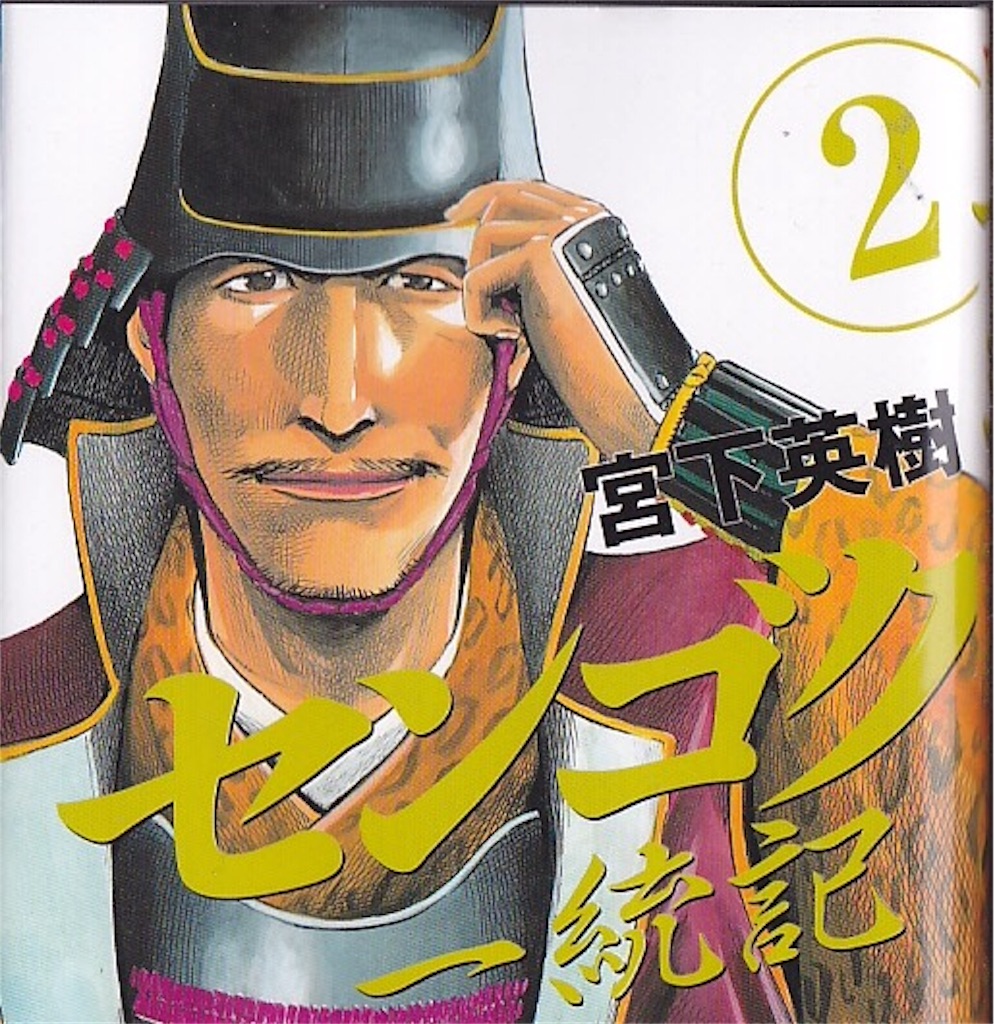
シリーズの第三弾となる「センゴク一統期」は豊臣秀吉が信長から引き継いだ天下統一の事業を描きます。この編は本能寺の変の後に繰り広げる織田家の両翼であった明智光秀と豊臣秀吉(当時は羽柴秀吉)の間に勃発し、世に言う「山崎の戦」から始まります。
The second installment, "Sengoku Ittouki (Sengoku: The Annals of Unification)", depicts Toyotomi Hideyoshi in his attempt to carry on Oda Nobunaga's quest to unify all of Japan. It begins with the Battle of Yamazaki, which pitted the two wings of the Oda clan, Akechi Mitsuhide and Toyomi Hideyoshi (known as Hashiba Hideyoshi at that time), against each other following the Incident at Honnoji.

「センゴク一統期」の前の編である「センゴク天正記」に戻ってみたいと思います。この編は1574ごろから始まりますが、実際の織田家と同様に光秀と秀吉がその中心人物となります。この二人は対称的に描かれているのは特に印象的です。狡猾かつ策略的で描写される光秀は「陰」を象徴する一方、明るい性格で失敗を挽回し前向きで描写される秀吉は「陽」を表しています。「陰」と「陽」はそれぞれ「夜」と「日」に当たるの如く、この二人の組み合わせで織田家の両翼が成り立っていました。切り離せばその成り立ちが崩れてしまいます。
Here I'd like to go back to the previous installment in this series, "Sengoku Tenshouki (Sengoku: The Tenshou Period Account). It begins around 1574, and just as was the case with the Oda clan in real life, the main characters driving the story are Mitsuhide and Hideyoshi. The symmetry crafted by the contrasting depiction of these characters is profound. The cold and calculating Mitsuhide represents the darkness, while the bright and positive Hideyoshi, who always makes up for his failures, symbolizes the light. Just as darkness and light make up night and day, these two individuals make up the two wings of the Oda clan. Separate the two and everything comes crumbling down.

この写真で写している一コマでは、漫画で描かれる上記の関係を見事に表している発言があります。
The cell pictured in this photo contains a quote that wonderfully shows how the aforementioned relationship between the two is depicted in the manga. Here's the translation.
「明るき光で導く将(秀吉)、合理的な光にて牽引する将(光秀)、
人はそのいずれに従ってゆくことになろう。」
"The leader that stands as the luminous light which leads the way (Hideyoshi), and the leader that stands as the force of logic which drives people forward (Mitsuhide). In the end, people end up following one of the two."

''The world will be turned on its head... With the masses ruling those who now rule them.''
宮武外骨:諷刺の世界へようこそ!Miyatake Gaikotsu: Welcome to the world of satire

宮武外骨(みやたけがいこつ)1867-1955。ジャーナリスト、文化風俗研究家、新聞雑誌研究家。香川県生まれ。明治20年「頓智協会雑誌」を創刊後、「滑稽新聞」「スコブル」など多数の雑誌や奇書を刊行し、反骨と風刺諧謔(かいぎゃく)に富む奇人として知られる。権力揶揄による入獄四回、罰金、発禁などの筆禍は29回に及ぶ。東大に明治新聞雑誌文庫を創設、主任を務める。
出所:「滑稽漫画館」、出版:河出文庫
Miyatake Gaikotsu, 1867-1955. Journalist, culture and folkways researcher, newspaper and magazine scholar. Born in Kagawa Prefecture, Japan. Published the "Witty Fellowship Magazine" in Meiji 20 (1887), followed by the "Hilarity Times Newspaper", "Tiptop", and a number of magazines and unusual volumes. Known as an eccentric who was fiercely defiant of authority and possessed a great satirical sense of humor. His belittling and ridiculing of figures in government landed him in jail four times. He was also forced to pay numerous fines, and his publications were banned a total of 29 times on account of the nature of the articles they contained. He founded the Meiji Shinbun Zasshi Bunko (Meiji Newspaper and Magazine Resource Center) at Tokyo University and served as its chief supervisor.
Source: Kokkei Mangakan, published by Kawade Bunko.

明治から大正の日本の風刺は今も生き生きしています。ここで宮武外骨の出版雑誌の一つであった「滑稽新聞」からの一部を抜粋して紹介します。この抜粋では宮武が漢字の「意味深い滑稽さ」を取り上げつつ、ある字の組み立てに置いて女性を貶す意味合いが潜められているではないかを読者に問い掛けていると思います。是非、外骨が垣間見させてくれる「当たり前の斬新さ」を楽しんでください。
The satire from the Meiji and Taisho eras (1868-1926) in Japan still rings through today. Here I have taken an excerpt from one of Miyatake Gaikotsu’s publications, the "Hilarity Times Newspaper". In this excerpt, Miyatake takes a look at the deep yet hilarious aspects of kanji. At the same time, I also feel that he is confronting readers with the fact that the elements of certain kanji seem to implicitly belittle women. I hope you all enjoy the “fresh new take on the ordinary” that Gaikotsu invites us to see.
Encyclopedia of Interpretative Kanji Treasures

(1)
(Man) Hey, it looks like you have more than one husband.
(Woman) That’s right. Just between you and mean, I actually have two.
Isn’t that why the character for husband is the combination of person (人) and the number two (二) (人 + 二 = 夫).
(2)
(Person 1) A man and woman engaged in an illicit affair have a child out of wedlock. Which one will be most satisfied with the fruit of their shenanigans?
(Person 2) Why the woman of course. When you breakdown the character for "happy" (嬉), it means "woman (女) rejoices (喜)."
(3)
(Person 1) When it comes to men and women, who do think is the most lecherous lot?
(Person 2) Definitely the women. Just take a look at the character for "to like" (好き). It’s a combination of the character for "woman" (女) and "child (子)".
(4)
(Person 1) "This (此) string (糸) is neither red nor blue. Exactly what color is it?
(Person 2) That’s what they call "purple" (紫).
(Person 1) Say, what’s "that" (其) rock (石) over there?
(Person 2) Don’t pretend like you don’t know. That’s a "go" (碁) stone*.
(5)
(Person 1) It seems that the bride-to-be (嫁) is always carted off to her waiting groom (婿方) at night time.
(Person 2) Of course it’s always at night! If they went carting her around in the daytime some envious fool would do something rash to hold up the parade. Take a look at that character for "marriage" (婚). There’s no coincidence that it’s written as "woman" (女) comes at "nightfall" (昏).
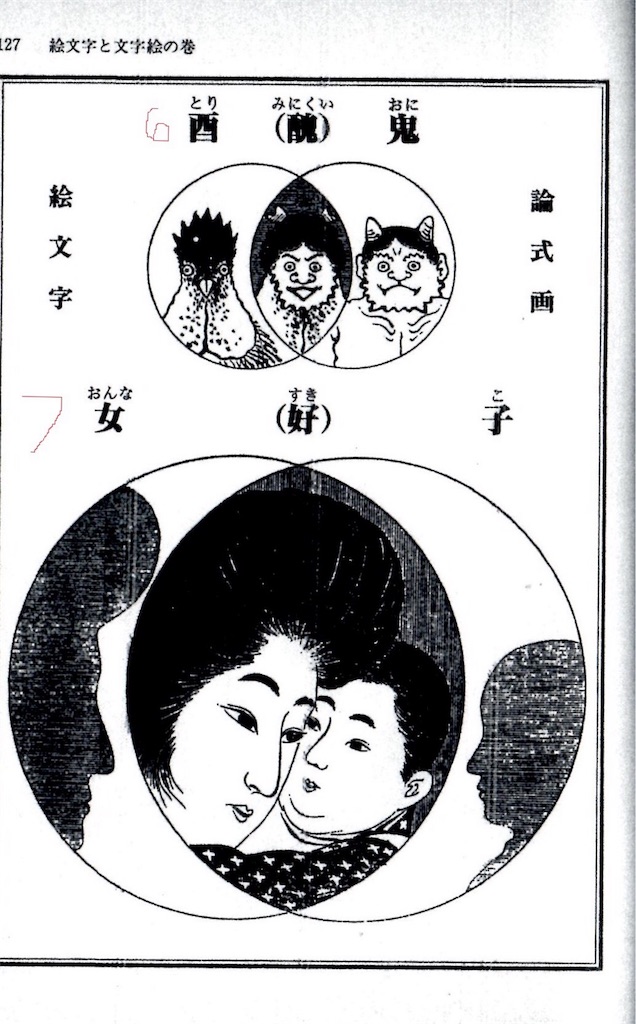
(6)
Chicken (酉) + Demon (鬼) = Ugly (醜)
(7)
Woman (女) + Child (子) = Like (好)
*Go: A board game which originated in ancient China that is widely played throughout East Asia.

武器で「構成」されている「平和」
The kanji characters for peace (heiwa) made up of weapons.
大名の行く道 The Way of the Warlord
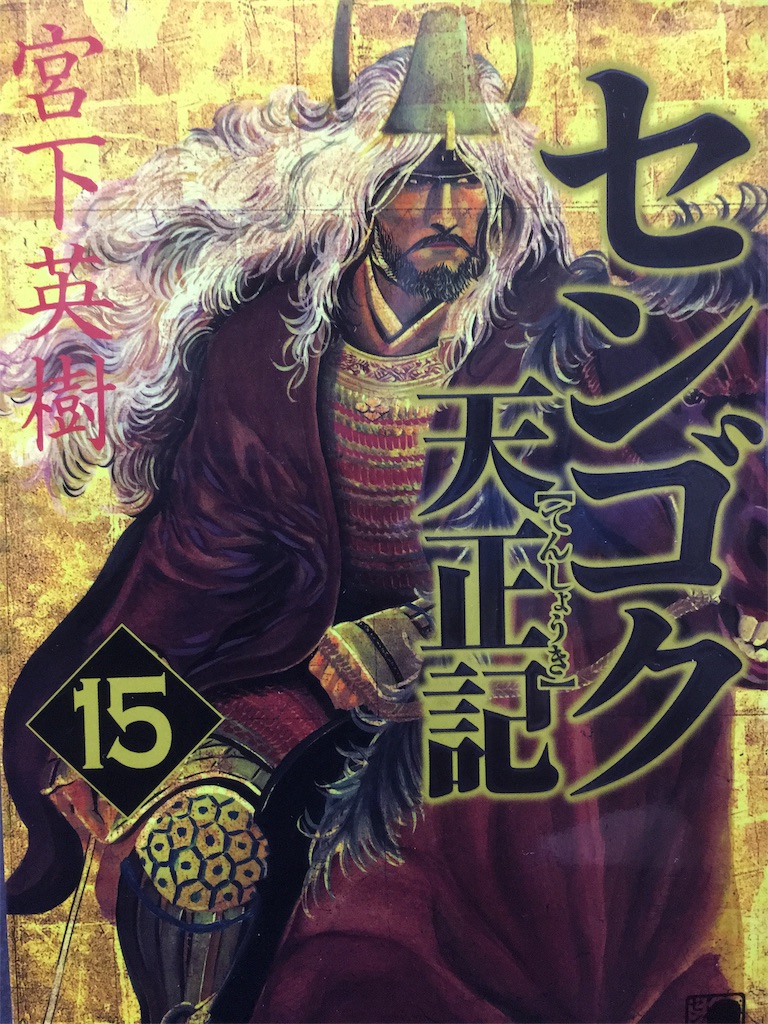
日本語において漢字のみで成り立つ四字熟語という表現を用いることが多く、一つの考え・思い・コンセプトに相当する意味がたった四文字に凝縮されています。拙僧は日本語に対する理解が深まっていくに連れて、多くの四字熟語を覚えて、その中に気に入りの一つは「栄枯盛衰」です。日本語を勉強するに当たって漢字という「壁」を嘆く方は少なくないでしょうが、たった一文字で色んな意味が伝わることを考えると利便性の高い書記であることが一目瞭然であると思います。動詞、名詞、形容詞、字の組み合わせによってその役割が決まります。この「栄枯盛衰」を字ごとに分解し動詞にしますと、「栄える」、「枯れる」、「盛る」そして「衰える」になります。
The Japanese language features many different yoji-jukugo (四字熟語) expressions that pack the meaning of a single idea/thought/concept into a four kanji character construct. I’ve come to learn a number of these expressions as my knowledge of the language has deepened, and one that I particularly like is 栄枯盛衰 (ei-ko-sei-sui). There are probably more than a few people that study Japanese who lament the significant hurdle that kanji poses, but as a written form of language it is incredibly convenient given how much can be expressed with a single character. Depending on how they are used in combination with other characters, they can act as verbs, nouns, and adjectives. When you break down the four characters in 栄枯盛衰 (ei-ko-sei-sui) into their verb forms, you get the following: 栄える (“sakaeru”, to prosper/thrive), 枯れる (“kareru”, to wither), 盛る (“sakaru”, to flourish), and 衰える (“otoroeru”, to fade/waste away).
辞書で上記の語彙の意味を調べますと、下記のような例文が出てきます。
「国が栄える」
「花が枯れる」
「火が盛る」
「文化が衰える」
「栄」、「枯」、「盛」、そして「衰」。この四つの字を見ると一瞬に上記の意味が頭の中に浮かんで、そして勝手に連想に走ります。拙僧にとって漢字の魅力、あるいは「魅惑」はそこにあり、それはまた漢字を勉強し使いこなせる醍醐味でもあります。
When you look these four verbs up in a Japanese/Japanese dictionary, you’re bound to find example sentences that read like these:
“The nation prospers” for 栄える
“The flower withers” for 枯れる
“The flame burns intensely” for 盛る
“A culture fades away” for 衰える
The instant you see the four characters (栄, 枯, 盛, 衰) that form the stem of these verbs, your mind instantly conjures up the meaning associated with these characters, and then races off on various tangents that they create. This to me is the charm, or rather the allure, of kanji, and embodies the satisfaction you gain from studying and then mastering these characters.

さて、漢字に関する余談をここで終止符を打って、本題に入りたいと思います。「栄枯盛衰」という四字熟語と初めて「出逢った」のは「センゴク天正記」という漫画シリーズであった気がします。この漫画は一般的な時代劇たる作品と違って、主に一次資料に基づいて徹底したリアリズム追及して描かれている作品です。 主人公となる仙石秀久権兵衛(せんごくひでひさごんべい)は織田家を支える柱のような存在となった羽柴(のち豊臣)秀吉に仕えた実際の武将です。物語は主人公の若かりし頃から追っていく形で展開し、彼が成長していく経緯を通して戦国時代の日本の社会的な変化を非常に如実に描きます。
Alright, I’ll bring this little discourse on kanji to a close and switch to the main topic I wish to write about. I believe the first time I “came across” the four kanji character construct 栄枯盛衰 (ei-ko-sei-sui) was in the manga Sengoku Tenshoki. Unlike most conventional period-piece manga, this series strives for uncompromising realism by crafting a tale based mainly on primary source documents. The main character is a man by the name of Sengoku Hidehisa Gonbei, a real life samurai who served under Hashiba (later Toyotomi) Hideyoshi, one of the key pillars in the Oda clan. The story follows Gonbei from his youth, and uses his growth as a vehicle for providing an extremely realistic portrayal of the changes in Japanese society during the Warring States period.
考えてみますと、「栄枯盛衰」という四字熟語は歴史の流れを見事に表現していると思います。川の流れの如く、激しくなることもありますし、また緩やかに流れることもあります。その川の流れの勢いを左右するのは河岸と地形であり、人間社会に当てはまるとそれは外からの影響や圧力に当たるでしょう。戦国時代の日本ですとその変遷が殊に激しく、大名家が凄まじいペースで台頭し、そして衰退していきました。センゴク天正記には数多くの大名家が登場しますが、特に印象に残ったのは武田家でした。最後の当主であった武田勝頼は定説によりますと父と比べて備えた器と能力が劣ったですが、最近の研究ですとその評価が抜本的に塗り替えて、一次資料から垣間見えるのは優れた先見性を持つ為政者です。ただし、一部の家来は過去の作法とやり方に固執してしまった結果、武田家がうまく時代の流れの変化を乗り切ることができず、最後に滅びました。センゴク天正記ではその運命に悟った武田勝頼の最期を見事に描かれて、そこに「栄光盛衰」という真理が鮮明に映っていると思います。漫画のなかにその見どころをやや時代劇いっぽくの口調で翻訳してみました。その英訳はイメージの下に掲載されています。
The four kanji character construct 栄枯盛衰 (ei-ko-sei-sui), in my opinion, perfectly describes the flow of history. Just like a river, the current of history can be both fierce and gentle. The river’s current is determined by its banks and the lay of the land, which would equate to pressure from external forces if we are to draw an analogy between nature and human civilization. These currents were especially intense during Japan’s Warring States period, with warlord clans rising and falling at an incredibly fervent pace. Many of these warlord clans appear in the manga Sengoku Tenshoki, but the depiction that stuck with me the most was that of the Takeda clan. The final ruler of this clan was Takeda Katsuyori, and according to the previously accepted historical narrative, he lacked the persona and skills of his father. However, recent scholarship has sparked a reappraisal of Katsuyori, with primary documents showing him to be a ruler with incredible foresight and vision. Unfortunately, some of his subordinates clung to old conventions, which ultimately prevented the Takeda clan from successfully navigating the changing tides and led to their demise. Sengoku Tenshoki paints an exquisite portrayal of how Katsuyori recognized the fate of the Takeda clan, and in my opinion provides a vivid reflection of the 栄枯盛衰 (ei-ko-sei-sui) principle at work. The text in the manga has a period-piece feel to it, so I tried to match that in my own translation of the text (placed below the corresponding images).
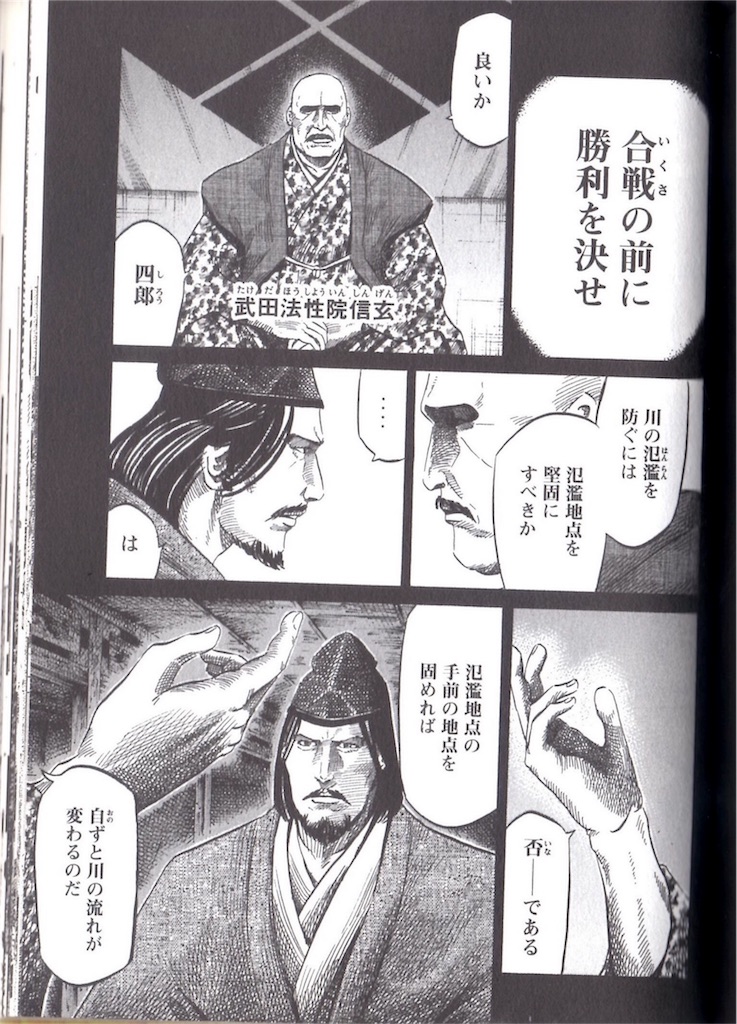
Shingen: Remember: Always secure victory before you even draw your sword.
Now tell me Shiro (Katsuyori), how do you prevent a river from flooding? Do you shore up the point where it’s most likely to overflow?
Katsuyori: Yes.
Shingen: (Long pause). No… you do not.
You shore up the spot just before it.
The river will then change course on its own.

Shingen: The same applies to both waging war and governing.
The key is to anticipate things before others.
My fault is that I failed to do just that.
I failed to maintain harmony within our own family.
This failure brought me to bury my eldest son and heir.
I couldn’t even bequeath to you the rightful rank of “yakata”.
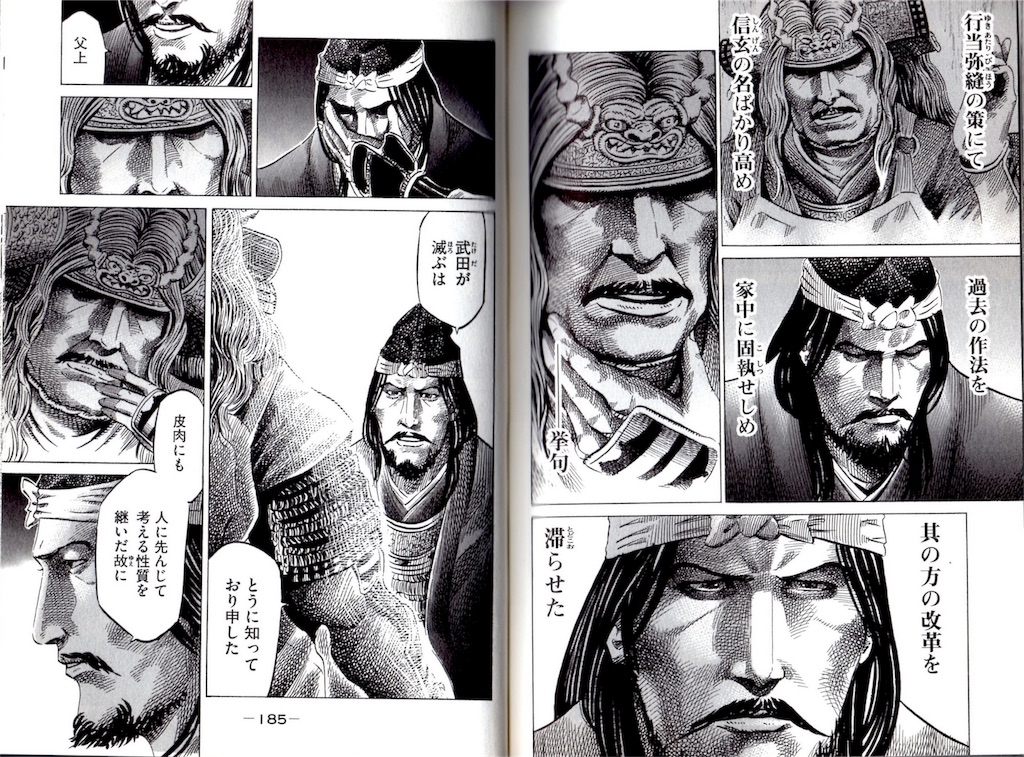
Shingen: All my stopgap efforts in governing did was to exalt this name of Shingen.
This makeshift approach caused our clan to cling to conventions of old,
thereby impeding the reforms you sought to enact.
Katsuyori: Father, I’ve known the Takeda clan was destined to fall for quite some time now.
Fate would have it that I inherited that same ability from you, that to anticipate things before others.

Shingen: So tell me why you, with your gentle heart, chose to fight and walk a path burdened with the iniquity of killing?
Katsuyori: I was searching… searching for what it truly meant to be a daimyo (warlord).
I finally found it the moment I laid torch to my own bastion.
The glory of a castle, an illustrious history of 450 years, the fame claimed in battle and rule…
All these things shall pass one day.

Thus it is I who shall be the one to extinguish the flame of the Takeda clan.
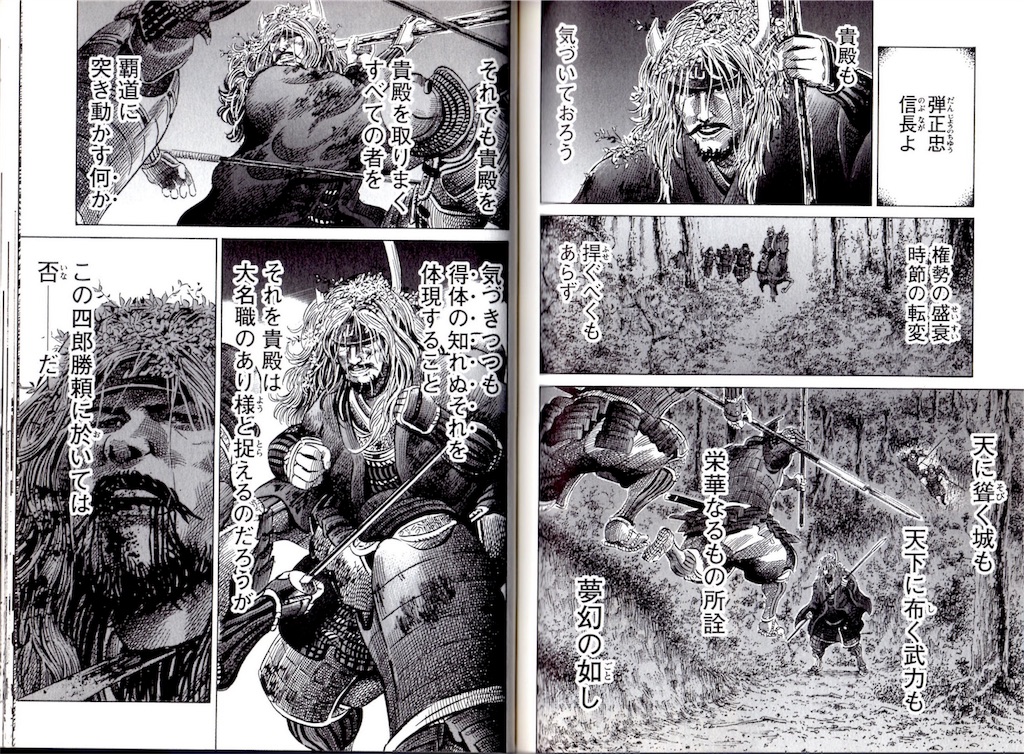
Katsuyori: You can sense it, too, Nobunaga.
The rise and fall of power, the turning of the seasons.
These tides are not to be resisted.
The castle that stands high against the sky.
The might wielded that holds sway over all beneath its sword.
All forms of glory are no more than fleeting dreams.
That element of power which drives you and all those around you…
The mystery which embodies that which you can sense…
In your eyes, that is the essence of a warlord, but I, Takeda Katsuyori, see something different.

Katsuyori: It is a burden that cannot be borne by others, one in which you bear all the sin and anguish around you.
In the end, you silently accept your fate, neither begrudging heaven nor blaming others…
That is the way of the warlord.
Takeda Daizen Daiyu Katsuyori
Slain at Mt. Tenmoku, age 37.
「曖昧な国」ニッポンのエンターティンメント Kabuki: Entertainment for Japan, the “country of ambiguity”

ちょうど2年前にPen雑誌が歌舞伎の特集を発行しました。本屋さんの本棚に並んでいたこの雑誌を見たとき、将来的にいい歌舞伎の「教科書」になると判断し、その場で購入しました。徹底した分析、そしてそのまとめはあまり網羅しすぎて、全部を完全に「消化」しきれていないです。その特集の紹介記事では非常に興味深いことが書かれていました。その記事によると、歌舞伎を通して、日本という国の歴史の流れ、あるいは日本という方法(プロセス)が窺えて来るとのことです。
Two years ago the Japanese magazine Pen came out with a Kabuki special feature. When I saw it on the shelves in the book shop, I knew it would make for a great future “reference” book on the subject, so I went ahead and bought it. The exhaustive analysis and depth of this feature simply blows my mind.
The introductory article to the special feature contained a fascinating passage. It essentially claims that Kabuki provides us with a window into the historical narrative, or more precisely the "process" of the country we know as Japan.

“曖昧な国”ニッポンのエンターティンメント
Kabuki: Entertainment for Japan, the “country of ambiguity”
(歌舞伎は)時代とともに変わってしまう面もあれば、普遍的な側面もある。変幻自在さが歌舞伎の面白さだ。
Certain aspects (of Kabuki) change with the times, while there are those that remain universal. The surreal and ever-changing nature of Kabuki is the very thing that makes it fascinating.

「歌舞伎には定本がないです。そこがシェイクスピアとは決定的に違う点。脚本主義ではなく、演出主義。歌舞伎=演出ともいえます。そして演出を伝えるのが役者です。西洋では、芝居は戯曲が本質になるのでしょうが、日本というのは本質の国ではないのです。あくまでも周縁に価値を置く。ディテールに優秀なものを残し、外側、表面、外面に対して力を発揮する民族です。それは文化を全部外から取り入れた。“周辺の国”だから。本質を問い詰めることなく、曖昧にしておく。常に外から文化を取り入れて、それが何故なのかということを考えない。脚本よりも演出が肥大化している歌舞伎は非常に日本的と言えます。」
“There’s no standard text (for a play) in Kabuki. That’s what sets it apart from Shakespeare. It’s not based on the notion of a script, but rather the performance. You could say that Kabuki is synonymous with performance, and the actors are the ones who deliver that performance. In the West, the essential substance of theater is the dramatic tale that is told. Japan, on the other hand, is a country with no actual substance to it. As a nation, Japan has always valued the elements on the fringes. The Japanese people leave the details of the highest caliber and demonstrate their prowess by channeling their energies into that which lies outside, on the surface, and on the exterior. The reason for this trait is that Japan has always imported culture from the outside. It’s a “country on the fringes” in every sense of the meaning. Japan never strives to pack in the essence of a specific culture, but instead leaves those elements shrouded in ambiguity. It simply takes in culture from the outside without ever really thinking as to why. Kabuki embellishes performance and makes it much bigger than the script, so in that regard as an art form it is extremely Japanese.”

まあ、この定義に基づいてきゃりぱみゅぱみゅを捉えますと、非常に日本的ですな。Da
Well, if you use this definition as the grounds for interpreting Kyari Pamyu Pamyu, then she is very Japanese. Surprising number of similarities between her and David Bowie's Ziggy Stardust.
https://www.youtube.com/
古田織部:乱世のエネルギーをもって、茶を革新した男 Furuta Oribe: The man who channeled the turmoil of the age to revolutionize the tea ceremony

*この記事は元々「Pen」雑誌の2009年の9月号に掲載された記事です。英文は数年前に拙僧が翻訳したものです。また、記事の最後にある注釈は拙僧が作成したものです。
This article originally featured in the September 2009 issue of the Japanese magazine “Pen”. The English is a translation I did a few years back. I also wrote the footnotes at the end of the article.

昨今は、マンガの主人公「へうげもの」(1)として、すっかり名を知られるようになった古田織部。千利休(2)亡き後、茶の湯の天下一宗匠として名を馳せるも、家康に謀反の嫌疑をかけられ非業の死を遂げた(3)武将茶人である。利休が死して伝説となったことに比べ、織部は残された資料が少ないこともあり、長らく忘れ去られていた存在だった。
Thanks to being portrayed as the main protagonist in the currently running manga Hyougemono (1) , Furuta Oribe’s name has been resurrected from the lost annals of history. Following the death of Sen no Rikyuu (2), Furuta rose to prominence and became the preeminent tea master in Japan. However, upon being suspected of conspiring against Ieyasu Tokugawa, samurai and tea aficionado Furuta met a rather ignominious end (3). While Rikyu went on to achieve legendary status following his own death, few records remain documenting the life of Furuta, leaving his name to be lost to history for hundreds of years.

だが、「茶の湯は人まねではなく、自由な創意こそ大切だ」という利休の思想を、最も生き生きと体現していたのは織部だろう。アヴァンギャルドな美学を思う存分、表現していった織部の芸術性は、もっと評価されていいのではないだろうか?
Though clearly overshadowed by the figure of Rikyuu, the claim could be made that Furuta succeeded in surpassing the genius of his master. Among the numerous disciples that Rikyuu had, none more vividly embodied the philosophy he espoused than Furuta: “the tea ceremony is not merely rehashing the precedent set by someone else, but rather the essence lies in liberating one’s creative energy”. Driven by a desire to release his own avant-garde driven aesthetic, Furuta’s artistic sense deserves much more credit than it has been given.
利休のストイックさと、対極にある大らかさ。
Juxtaposition of Rikyuu’s stoicism and Furuta’s open-minded approach

武人としての織部は、勇猛果敢な武将というよりは、ネゴシエイターとしての活躍が光る。敵方の武将を説得して味方に引き入れることに幾度も成功し、信長や秀吉の信任を得ていた。その巧みな交渉力は、織部のストレートで大らかな人柄によるところが大きいと言われている。
Furuta’s true acumen as a warrior lay not in his daring exploits on the battlefield, but rather in his skills as a negotiator. On numerous occasions he succeeded in persuading enemy generals to change sides, earning him the staunch trust of Oda Nobunaga and later Toyotomi Hideyoshi. Many believe that Furuta’s deft negotiating abilities were largely the product of his open-minded and tolerant disposition.

そうした大らかさは、茶の湯においても遺憾なく発揮された。師である利休の侘び茶と対極の、渦巻くようなエネルギーは圧巻だ。利休が静であり引き算なら、織部は動であり足し算。
Nowhere is this more evident than in the tea ceremony style that Furuta created. In stark contrast to austere aesthetic that pervaded the style of his master Rikyuu, Furuta unleashed an overwhelming flood of energy as virulent as a whirlpool. If Rikyuu embodied the ying, then Furuta was most certainly the yang.

織部好みの焼き物は、そうした個性の表れだ。自身の名を冠した織部焼の茶碗は、強い歪や現代アートのように大胆な文様など、自由闊達な魅力に溢れている。懐石用の器も、六角形や八角形、扇などの具象形、奇抜な不整形など、従来の形から大きく逸脱した造形だ。織部ンお実際の政策にどこまでタッチしたかは不明だが、アートディレクターとして現場の自由な創造を促したことは間違いないと思われる。
Furuta’s unique sense is perfectly reflected in the earthen vessels that he favored. The ceramic creations that bear his name, Furuta-yaki, are bursting with unbridled charm. These works are characterized by their exaggerated deformation and bold designs that are in the same vein as contemporary art. The formative style of Furuta-yaki left standard designs by the wayside and aggressively pushed the bounds of artistic expression with its ambitious forms, ranging from geometrically based hexagonal and octagonal shapes to fan-shaped representations and outlandishly misshapen creations. It is not entirely know how involved Oribe was with the actual production of each vessel, but there is little doubt he was on site as the artistic director, the driving force propelling the creative energies of each artisan.

井戸茶碗「十文字」は、織部の並外れた美意識を物語る品の一つ。名器とされていた高麗茶碗を、大ぶりすぎると4つに割り、寸詰めして十文字に継ぎ合わせたというから驚かされる。
A telling representation of Oribe’s eccentric aesthetic eye is the Ido tea vessel “Juu monji” (literally “the cross”). Oribe defied logic by taking a Goryeo (4) tea vessel, regarded to be a masterpiece in its own right, and smashing it into four pieces. After breaking the vessel apart, he scaled down the size and put the pieces back together to create a cross-based design.


茶室に関しても、織部の相違は留まることを知らない。極端に狭く、ほの暗い小宇宙だった利休の茶室に対し、織部は空間を広くとり、窓もたくさん設けて明るさを採り入れた。京都の藪内家燕庵は、伸びやかな織部らしさが表れた代表的な茶室である。
In addition to his avant-garde approach to tea vessels, Oribe’s creative vision for designing tea rooms was equally unbounded. While Rikyuu preferred dark and enclosed spaces that seemingly transported guests to outer space, Oribe enlarged the size of the room and incorporated a number of windows to allow light to flood the interior. The Yabunouchi Ennan in Kyoto is a representative example of Oribe’s tea room style.

コンセプチュアルな侘び茶が難しすぎると感じていた当時の人々は、明快でポップな織部の茶を大歓迎。彼の押しも押されもせぬ茶人になっていた。こうして振り返ってみると、織部の直感的で大胆な個性は、戦国時代の武将たちがもつエネルギッシュで豪胆な気風を反映しているとも言えそうだ。太平の世の江戸期になると、個としての我武者羅な活躍は徐々に否定されていく。織部は、乱世的エネルギーをアートに持ち込んだ、最後の残り火なのかもしれない。
Furuta’s interpretation of the tea ceremony was a revelation to the people of his times. Many felt that the conceptual and austere style of Rikyuu was rather difficult and abstract. Furuta’s straight-forward approach and “pop” sense struck a chord with the masses, and propelled him to stardom as the premier tea master in Japan. In retrospect, one could say that Furuta’s instinctive and audacious character perfectly reflected the vivacious and ambitious spirit of samurai generals in the Sengoku (Warring States) period. As the age of internecine warfare gave way to the tranquil peace of the Tokugawa (Edo) era, the hell-bent drive and action born of uncompromising ambition were slowly abandoned. Furuta may well have been the last blazing light of his era, the man that perfectly channeled the turbulent fervor of an age rife with conflict to produce art that still resonates with us today.
(1) 大好きな漫画作品の一つ。完成度の高い歴史的な脚色であり、現代の文化を円滑に取り入れながら(章のタイトルはポップ曲のタイトルにちなんだものにしたりするなど)、大げさにならないようにそのポップ的な要素を巧みに抑える。絵の表現は主人公たる織部の個性を見事に強調し、見事に引き出す。
This is easily one of my favorite mangas. It is a well-written piece of historical fiction that seamlessly weaves references to contemporary pop culture (naming chapters after classic rock songs) without looking clichéd or over-the-top. The art only helps to further accentuate the zany character of the protagonist.
http://hyouge.exblog.jp/
(2) 堺(現在の大阪府)の商人(あきんど)。現代の茶の湯を完成し、その始祖者とされる。
Sen no Rikyuu was a merchant from Sakai (present day Osaka-fu) that is considered by many to be the father of the modern tea ceremony.
(3) 要は、切腹が命じられた。
To put it bluntly, he was forced to ritually disembowel himself.
(4) 高麗は918に創立し、1392まで朝鮮半島の大半を治めた王朝であった。現在の韓国の英語名「Korea」はこの王朝の名前から由来する。非常に洗練された文芸を生み出した王朝であり、その一つは東洋の国に置いて高く評価され求められた焼き物である。
Goryeo is the name of the Korean kingdom (from which the nation derives its name) that ruled over most of the Korean peninsula from 918-1392. One of its most notable cultural achievements was its celadon pottery, which was highly prized throughout the region.